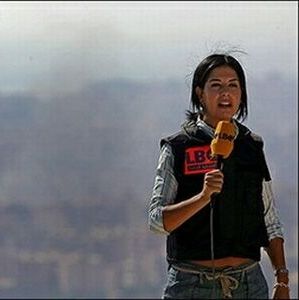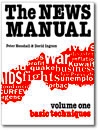DogBitesMan » Journalism » Women and war reporting
Women and war reporting
June 1st, 2009 | Add a Comment
Around the world, women are playing an ever more active role in journalism and the media. In many countries they now enjoy equal opportunities with men, and more and more of them are in senior management roles running media organisations.
 Once upon a time this would have been quite rare, even in developed nations. Just 30 years ago, for every Katherine Graham publishing The Washington Post there were hundreds of women who could only dream of careers in the media or who were struggling up the journalism ladder actively opposed by men. As a rough guide, of the 82 journalists listed as notable War Correspondents in Wikipedia, only 20 are women. This imbalance may be lessening but is still true in some countries even now.
Once upon a time this would have been quite rare, even in developed nations. Just 30 years ago, for every Katherine Graham publishing The Washington Post there were hundreds of women who could only dream of careers in the media or who were struggling up the journalism ladder actively opposed by men. As a rough guide, of the 82 journalists listed as notable War Correspondents in Wikipedia, only 20 are women. This imbalance may be lessening but is still true in some countries even now.
In the early years, women were often limited to reporting social or family issues; their male colleagues kept juicy rounds such as politics, economics and crime to themselves. These barriers have now broken down in many countries and are collapsing in others.
One of the last bastions of male dominance in journalism is war reporting. Men overwhelmingly fill the ranks of war reporters, even though most of the victims of war and conflict are women and children. Critics say this is why war coverage in most countries is still very much slanted towards macho aspects such as armies, weapons, explosions, body counts and territory gained and lost.
Reporting conflict is also driven by confronting images, by film of fighting, by photographs of the dead and injured. Whether journalists like it or not, many media consumers – especially men – are more drawn by short, sharp and shocking images and breathless reports from the battle front than by less dynamic pictures or more thoughtful reports of the effects. This is one of the challenges posed by most fields of journalism.
Covering the fighting and exposing the brutalities of war are important, but they can easily overwhelm insightful in-depth reporting about the effects on ordinary people caught in conflicts: death and mutilation, rape, starvation, homelessness, poverty, disease and the breakdown of families.
Many great male journalists have demonstrated that men can report on these issues with empathy equal to any of their female colleagues. The gender of individual reporters is not the determining factor. But critics say that only when more women are in positions of influence in reporting conflict will those human stories be consistently told, not only because women might report them more but also because women will drive the debate on what aspects of war and conflict should be reported beyond the guns, bombs and soldiers. Male reporters will come to see them as more important too.
A recent conference in Australia highlighted how far the debate still has to go, even in a country with well-developed, equal-opportunities media.
Experts from around the world attended the “Reporting Wars: Challenges & Responsibilities” conference organised by the University of Technology Sydney, the International Committee of the Red Cross (ICRC) and the Australian Broadcasting Corporation (ABC).
The keynote speaker was Chris Cramer, the New York-based Global Editor for Multimedia at Reuters News, the world’s largest international news agency. Other speakers included Florian Westphal, head of media and public relations for the International Committee of the Red Cross (ICRC) in Geneva and Bruce Shapiro, executive director of the Dart Center for Journalism and Trauma based at Columbia University in New York.
Other panellists were drawn from the senior echelons of active print and broadcasting journalism in Australia together with academics, union leaders and the officer in charge of the Australian Defence Force’s public affairs department, Brigadier Brian Dawson.
The conference covered a host of topics related to reporting wars and conflicts: relationships between humanitarian agencies and journalists, international humanitarian law, the military and the media, practical reporting from the front line, and the safety and protection of journalists.
Significantly, while several women were involved in organising and moderating sessions, of the 18 guest speakers and panellists, only three were women – UTS Professor Wendy Bacon, ICRC law adviser Helen Durham and Louise Williams, a former foreign editor for Fairfax Media and the only female speaker to have been a full-time foreign correspondent.
A similar conference organised in Wellington, New Zealand, by Massey University, the ICRC and Red Cross New Zealand was similarly weighted in favour of men. Again, only one woman, TVNZ journalist Barbara Dreaver, had experience as a full-time foreign correspondent. She moderated the session on reporting from the front line.
I point this information out not to criticise the organisers, who put much time and effort into staging important conferences on a significant topic, but to illuminate the problem faced by the media – and by implication the societies we serve – in the coverage of conflict.
Without more women actively involved in the processes of reporting conflicts – from reporter, photographer or camera operator through to foreign editors and editorial managers – the basic style and content of war reporting will continue to reflect the current concentration on military aspects, where women and children are most often seen as little more than victims, either as targets of weapons or as “collateral damage”.
There are, of course, many brave and competent women war reporters, risking their lives beside their overwhelmingly male colleagues and the answer is not simply to increase their numbers, if that were possible in many countries.
ABC foreign affairs editor Peter Cave said more and more women were serving as foreign correspondents, though he added: “I would, as an editor, be a little bit concerned if a woman was reporting just from a woman’s point of view because she was a woman, just as I would be concerned if a man was reporting from a man’s point of view because he was a man.”
Veteran war reporter Ian McPhedran got closer to the heart of the issue when he added: “There’s more to war than just military activity and obviously the victims of war are mostly women and children.” But he felt the male correspondents he knew covered those issues well and he did not think reporting was “too macho from a coverage point of view”.
Many women journalists – and consumers of the media – might disagree, and it is perhaps unfair to expect most men in an overwhelmingly male profession covering an undeniably male activity – making war – to appreciate the subtle differences to reporting on the women and children affected by war and conflict.
Yes, they are victims – but they are much, much more than that. And their stories, the way they cope with war and try to rebuild shattered lives, are much more complex and deserving to be properly told.
First published in The News Manual in June 2009
____________________
Although there are numerous interesting books and blogs about women war reporters and several anthologies of their reports – though almost exclusively Western journalists – there is still not much literature discussing the effects of gender on reporting war and conflict.
- The BBC’s Hilary Andersson wrote an article in the British Journalism Review about women reporting the Iraq war.
- While not exactly about the issue of reporting war from a feminine perspective, this discussion by women attending a conference at the Dart Center for Journalism & Trauma gives interesting insights into the practicalities of Western women journalists working in conflict zones.
- This, by British journalist Christina Lamb, describes being a mother and a war reporter.
- This article in Arab Media & Society looks at Lebanese women journalists in conflict zones.
- Women’s eNews reports on six Iraqi women reporting the war from women’s perspectives.
- The Muslim Woman wrote about Arab women correspondents reporting live from the Israel-Lebanon war zone.
Filed under: Journalism · Tags: ABC, Arab Media & Society, Australian Broadcasting Corporation, Barbara Dreaver, Brigadier Brian Dawson, British Journalism Review, Bruce Shapiro, Chris Cramer, Christina Lamb, Dart Center for Journalism and Trauma, Fairfax Media, Florian Westphal, Helen Durham, Hilary Andersson, human interest, Ian McPhedran, International Committee of teh Red Cross, Israel, ITC, journalism, Katherine Graham, Lebanon, Louise Williams, Massey University, media, Peter Cave, reporting conflict, Reporting Wars, Reuters, The Muslim Woman, University of Technology Sydney, UTS, war correspondents, war reporting, Washington Post, Wendy Bacon, women reporter, Women's eNews
Recent Comments
- Bernard Sinai on Goodbye Mr Grass Roots
"With the Queen's public birthday coming up I'm just picturing how Rootsie would …" - Phil Ryan on Cheers or tears for SBS?
"I look forward to more productions of similar nature and quality to "The First A…" - Paulo Alberton on About
"Thanks David for the insights... I just discovered you and will explore more of …" - topdog on Endless war between newsroom and classroom
"The problem, Shameless, is that the academics generally see the freedoms and res…" - Shameless on Endless war between newsroom and classroom
"I cant see what the problem is. The academics say they believe in free speech an…"













